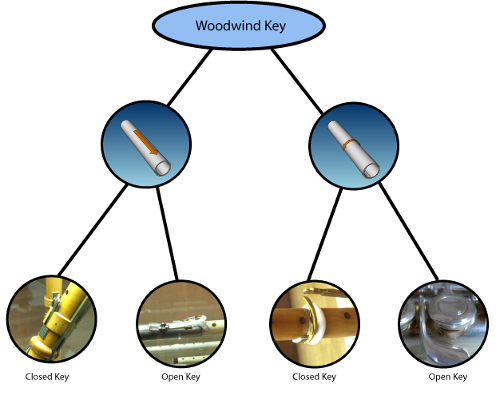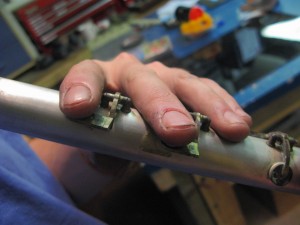Greetings once again from the MK-workshop, despite the relative radio silence on these pages on the subject of the Toob chromatic whistle, things have been ticking over. Now seems like the right time to get the work we’ve done out there and get some feedback on some of the ideas, so I hope you’ll get involved in the comments below. Part of preparing this is also to aid us in pulling together what we’ve done and trying to get an overview of the design options.
A Family Tree
Starting from the basics, we are looking to create a chromatic whistle. One of the interesting challenges faced with the design of any chromatic woodwind instrument, is that you only have nine effective fingers (you need a thumb to balance the instrument on), but there are twelve notes in the chromatic scale to cover. Therefore we inevitably have to add keys, so the first question is, what form can keys take?
The above diagram is an attempt to broadly categorize the various types of key mechanisms to be found on woodwinds. You can have one which is normally in its open state until actuated or one starting in the closed position. Depending on the key arrangement and the player’s hand posistion, keys will work along the body of the instrument or around it. The aim with the ‘Toob’ is to create keys which are normally closed and that act around the body of the whistle, as we are adding notes and keys whilst retaining a familiar playing position for trad whistle players.
So we focussed very quickly in on this particular ‘species’ of key and a melting pot of different key ‘breeds’ has evolved;
The option above left ‘posts with pin hinge and spring’ is very much our base option, that formed the results of Misha’s previous bout of prototyping and development. This is a strong and solid foundation for the design, it tested the key positions for comfortable play and uses a mechanism that is tried and tested. Looking at it together and asking what more could we do to push the design of the Toob further, we homed in on the way that these keys clutter the top surface of the instrument. Depending on the size of the player’s hands the protruding key mechanisms could be a hindrance.
From this starting point, what you see in the other options shown above were attempts to create a key mechanism that is as low-profile as possible. Our broad two ‘sub-species’ then were the ideas of an ‘overslung’ (as in the original case) or ‘underslung’ key, which has its mechanism below the body of the whistle. The ‘underslung’ key is perhaps the extreme case, making the upper tactile surface of the whistle completely smooth and visually clean. An underslung key requires the same mechanism as the overslung, but with an additional actuator which faces the fingers of the player. This additional complexity hasn’t made it a favourite at the moment.
An ‘overslung’ key has two main functional elements; a pivot point and a spring which holds the tonepad in position. The spring force specification has to offer a key which is light and responsive to the musician’s touch but robust and reliable in holding the tonepad closed. In all of the options above we have explored replacing the traditional woodwind key springs with flat leaf springs that are very much more part of the key structure and used in a very visible way. What particularly distinguishes the various options though is the approach to creating a pivot, from not having a pivot at all but rather a cam action over the whistle to retaining a hinge pin against the whistle with a plate element.
As you can see from the images in our family tree we’ve spent quite a bit of time prototyping these ideas and directions and I think it’s worth describing each of them in more detail. So please check back with the MK Design Blog over the coming days for a more in-depth look at our key concepts, taking each in turn.




4 replies on “The Woodwind Key Family Tree”
great post Brian. Looking forward to working with you on forthcoming developments…
“Starting from the basics, we are looking to create a chromatic whistle. One of the interesting challenges faced with the design of any chromatic woodwind instrument, is that you only have nine effective fingers (you need a thumb to balance the instrument on), but there are twelve notes in the chromatic scale to cover. Therefore we inevitably have to add keys, so the first question is, what form can keys take?”
I’m sure other people have made the same point, but keys are necessary only if you want to avoid cross fingerings.
Chromatic whistles have existed for centuries, in the form of the recorder. The instrument is made chromatic by using 7 to 9 toneholes on the top of the tube, and uses cross fingerings to play notes outside its home key (F for alto, for instance).
I’m sure that a chromatic whistle could be designed with 7 holes, using cross fingerings and half-holing for the lowest accidentals.
Hi Rob, of course, you are certainly right. My apologies for my rather glib intro to the project, my head is so far into the details that my attempts to summarise the project so far were a bit feeble. I was trying to paraphrase Misha’s original concept which he had established before I came on board – to have (Misha correct me if I’m wrong) a key & tonehole layout as close to a standard whistle as possible, lowering the learning required to use it. The keys are effectively the black notes on the piano sitting between the notes that players are used to, adding notes without having to learn cross-fingerings.
Certainly we don’t want to re-invent the wheel or ignore the vast heritage of woodwind instruments that are out there, but we hope to offer something complementary that will fill a need for an audience of players out there.
Thanks for getting involved in the conversation, hope you’ll come back to watch the developments.
[…] on from my previous posts on the toob key design (overview, Part 1) and moving further through the “family tree” I’d like to take you […]